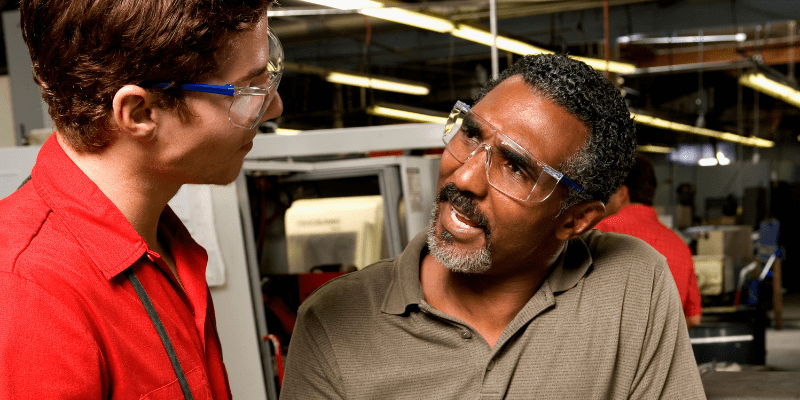7 ways to harness the health and safety potential of your multi-generational workforce

Multi-generational workplaces are now the norm in Ontario. And that’s good news, says WSPS Consultant Tova Larsen. “Tapping into the diverse perspectives, talents, and experiences of each generation – whether baby boomers, Gen X, millennials, or Gen Z – can boost health and safety creativity, innovation, and productivity.”
Each generation brings unique insights and approaches to problem-solving, which can enhance the development of safety protocols and practices, explains Tova. “Older employees, for example, may have extensive industry knowledge, practical insights, and historical context for how and why a situation is occurring, while younger employees may be more familiar with the latest standards, safe work practices, and technologies, contributing to novel safety solutions.”
To harness this health and safety potential, workplaces need to address the challenges that come with managing diverse generations. They may include:
- a belief in negative stereotypes about other generations. “Negative stereotypes are poisonous to harmonious working relationships,” says Tova, “and do not reflect the unique talents of each generation.” If your workers and/or supervisors and managers hold these beliefs, it can lead to a breakdown in communication and a failure to address safety concerns effectively, she warns. It can also lead to workplace harassment.
- different safe work attitudes. This can lead to both intergenerational friction as well as unaddressed hazards, says Tova. Here are a few examples:
- an older worker fails to report a hazard, saying, “It’s fine. It’s always been this way, and I haven’t been hurt,” while a younger worker who has just completed a safety training course looks at the same hazard and says, ‘I’m not doing that. It’s not safe,’ and reports the hazard.
- an older worker warns a young worker about a hazard, saying, “That is dangerous. Don’t do such and such.” The inexperienced worker, who still believes themselves ‘invincible’ to harm, shrugs it off and continues to put themselves at risk.
- a new worker has concerns about psychological safety but is afraid to approach the manager, who, although only slightly older, is focused exclusively on traditional safety.
Employers with a multigenerational workforce need to be adaptable and creative when it comes to promoting harmonious working relationships with a focus on health and safety. Here are Tova’s 7 tips.
7 tips for ensuring every generation is on the same page
1. Put safety first. “Each generation may have different viewpoints, beliefs and preferences, but the goal for everyone is to get home safe at the end of the day,” says Tova. “If we can unite around that singular purpose, it can cancel out all the other noise and act as a bridge between generations.”
2. Provide opportunities for cross-generational training. For example, younger workers can help millennials learn how to use new reporting software, and baby boomers can show Gen Z workers the ins and outs of pedestrian safety around forklifts. “If you can get different generations working together, they get to know each other and appreciate each other a bit more. If you can appreciate someone as a person, you’re a lot more likely to listen to their perspective.”
3. Create a culture of respect. “While it may be tempting to dismiss concerns coming from younger generations about mental harm, incivility, harassment, homophobia, and transphobia as trivial, the Ontario Human Rights Code and workplace violence and harassment legislation in Ontario establish robust protections that employers must abide by,” notes Tova.
“Set all workers up to understand that the bar for respectful interactions has changed over time and clearly establish your organization as a place where negative behaviours are unacceptable. “This holds doubly true for journey people mentoring apprentices,” says Tova. “Younger workers today are generally unwilling to tolerate being treated the way apprentices may have been in generations past. Be patient and kind. They’re there to learn, not be hazed for being new.”
“Respect cuts in both directions on the generational spectrum. Younger workers may need a primer on respectful boundaries, professionalism, and collaboration skills.”
4. Tackle your own prejudices and go easy on labels. “While generational labels can help us understand demographic trends across populations over time, they’re not nearly as effective at helping us understand each other as individuals. I’d be really careful about assuming what someone might know or believe, or how they work, based on the generation they were born in,” cautions Tova.
“Check your biases. If you find yourself assuming a boomer will never wear safety gloves because it’s not what they’re used to or that a Gen Z will automatically be overconfident and dismissive of training, stop! Get to know your team members individually, their work styles, their strengths, and their preferences, and use this information to tailor your safety messaging.”
5. Set clear organizational expectations. “Say the silent part out loud,” says Tova. “If you don’t want workers to make assumptions about expectations (and you don’t), you have to set those expectations.” This will help to prevent conflicts among generational groups of workers and between managers and workers from different generations. “For example, baby boomers may automatically stay late to finish a project, while their Gen X partner leaves early because work/life balance is a priority. Both may feel miffed with the other for different reasons.”
“If you expect people to stay late to finish a project, say so in your job ad and in your performance objectives so everyone is on the same page. This applies to communication as well. Set expectations about what each communication method and platform is used for.”
6. Be flexible when it comes to training. “Consider the learning preferences of each generation when providing health and safety training,” says Tova. For example, baby boomers may prefer to attend classroom lectures with printed learning materials. Gen X may prefer self-directed learning modules that they can complete in the order and at the pace of their choice. Millennials may prefer training that allows them to work together and have some fun. And Gen Z workers may prefer bite-sized video shorts and online forms.”
“I would encourage workplaces to marry different training approaches together,” says Tova. “And always follow up with hands-on, practical training for all generations to maximize learning.”
7. Don’t micromanage. “Provide sufficient safety supervision to ensure everyone is working in a healthy and safe way, using previously established safe work practices, personal protective devices, equipment and clothing. Be a source of support and help as staff work towards completing their tasks, but don’t overdo it.”
Resources
- Is unconscious bias impacting your workplace? 5 steps to foster inclusivity (article)
- Trusted Leader Blog: Create a Safe and Inclusive Culture For All Ages
- 9 tips for engaging older workers (article)
- Does your health and safety program consider older workers? 8 tips to support them (article)
The information in this article is accurate as of its publication date.




